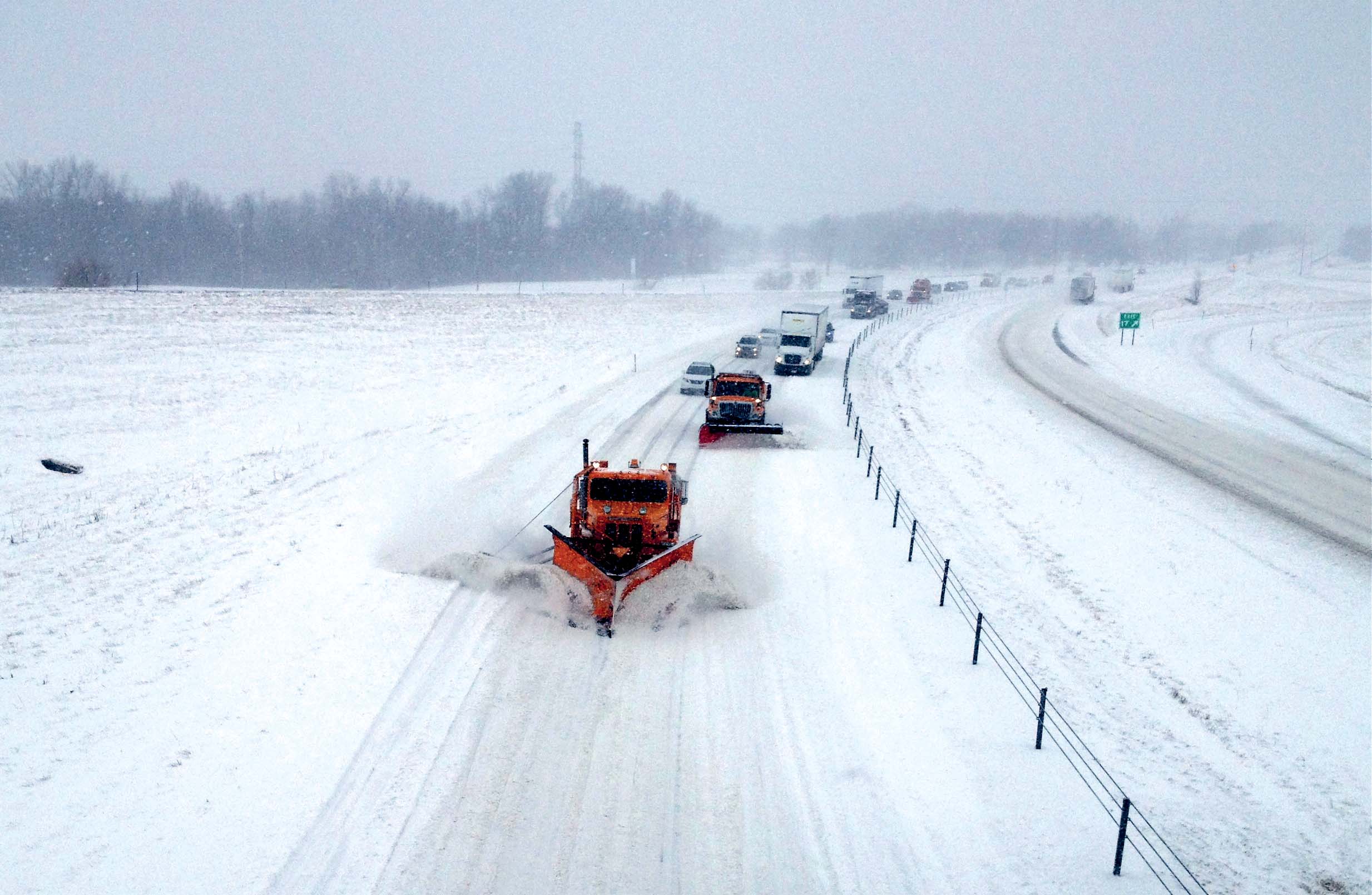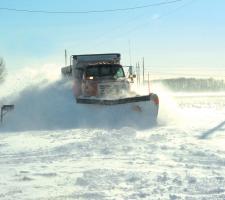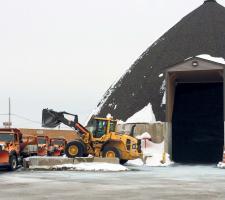
ITS solutions are helping streamline winter road maintenance for Delaware and Illinois, two states that must deal with dynamic weather and varying snowfall totals. Andrew Bardin Williams reports.
Wilmington and Newark (pronounced new-ark) are two vastly different cities that sit on opposite ends of Delaware. Newark is a sleepy university town of roughly 30,000 residents abutting the state’s western border with Maryland and Pennsylvania, and often gets confused with its larger namesake in New Jersey.
On the state’s eastern border along the Delaware River sits the larger and more cosmopolitan Wilmington, a favourable tax haven that is considered the “Corporate Capital of the World” due to the large number of company headquarters in the city. Wilmington was the first Swedish settlement in North America, and is now home to 70,000 residents—including Vice President Joe Biden who commutes every day to his office in Washington on Amtrak.
The cities’ climates are representative of their vast differences. According to US Climate Data, Wilmington receives an average of 490mm (19 inches) of snow annually while Newark comes in at less than half that total with 200mm (eight inches). The catch? While bookending the country’s smallest state, Newark and Wilmington are only 24km (15 miles) apart.
Despite their close proximity, the cities sit across the infamous snow/sleet/rain line that often runs up the I-95 corridor, drenching some cities while burying others. The unpredictability of storm paths, moving front boundaries and varying topography (shore to flood plain and rolling hills) wreak havoc on Delaware Department of Transportation’s (DelDOT) preparedness for clearing and maintaining the state’s roads.
“It’s our job to get the state back up and running during and after big storms come through the area,” said Mark Alexander, director of maintenance and operation for DelDOT. “That includes public services such as emergency services, schools, mail service and transportation. And we have to ensure commerce continues to flow throughout the state.”
According to Alexander, performance standards dictate that after a 100mm (four-inch) storm, major roads must be cleared within 24 hours; 48 hours for a 100-200mm (four to eight inch) and within 72 hours for even bigger storms. But the uncertainty and variance of snowfall around the state make it difficult to put appropriate resources in the field to meet those standards—at least in an efficient manner.
It’s not uncommon for a storm to dump 300mm (one foot) or more of snow on Wilmington while it’s raining in Newark - just 24km (15 miles) away - with a wintery mix in between. Snowploughs deployment needs to be prioritised with a limited supply of salt spread on road surfaces to mitigate dangerous driving conditions. To do this DelDOT’s road maintenance personnel need accurate weather condition information to make intelligent decisions.
ITS Solutions to the Rescue
More than 20 ScanWeb weather stations - each the size of a hockey puck - are buried in road surfaces and bridges across Delaware, transmitting information including air and road temperatures, precipitation totals, wind speed and other data points to an online dashboard. This data is accessible to road maintenance personnel from any device with a web browser and is merged with information from an online weather service that provides hyper-localised forecasts.
Combined with data collected by sensors mounted on snowploughs, DelDOT can get a detailed sense of current and predicted road conditions, to improve road clearance efficiency. GPS trackers allow the authority to monitor the ploughs’ locations and ensure roads are being cleared according to the department’s strategy and protocol. The interactive map also helps get mechanics to broken down ploughs more quickly while providing DelDOT with reliable location information when dealing with resident complaints.
Additional sensors on the ploughs monitor salt usage and automatically adjust the speed of spinners and direct drivers to the nearest storage facility when they start to run low. The information can be downloaded after storms for post-even analysis. Inventories at salt barns are typically monitored by sight, however Alexander says the South District has installed GoPro cameras that photograph and automatically triangulate volume. He hopes the practice is adopted by other districts before the winter season.
Even the maintenance of road maintenance equipment has been streamlined by ITS technologies in Delaware. New wash racks can clean two vehicles at a time from platforms stationed above ploughs, allowing workers to get to spinners and plough blades more easily while saving water. The ultimate goal is to reduce wear and tear on equipment and thereby the repair costs.
Data Collection
Serving a large state that spans nearly 640km (400 miles) from the Great Lakes in the north to the confluence of the Mississippi and Ohio Rivers in the south, the Illinois Department of Transportation (IDOT) also faces dynamic weather patterns and must rely on accurate weather and road surface conditions to make strategic ploughing and salt decisions in real time.
According to Guy Tridgell, deputy director of communications, the state typically sees 35 storms per winter, ranging from mild to extreme - sometimes within the same event in different regions across the state.
To combat dynamic, unpredictable conditions, IDOT has deployed Road Weather Information Systems (RWIS) to provide specific information on pavement and climate conditions. This information is integrated into a Maintenance Decision Support System (MDSS) that continually analyses changing conditions during a storm and provides treatment recommendations down to specific sections of roadways. It’s then fed to plough operators in the field who can adjust salt output as needed or be redirected to roads with greater need.
IDOT’s winter road maintenance personnel keep salt usage to a minimum to mitigate the environmental damage the chemicals can cause. Knowing when and where material is needed and optimising spread can reduce the total amount that is released into the surrounding area, both preserving wildlife and saving taxpayers money.
Speaking of taxpayers, weather and road conditions need to be disseminated to the public. IDOT operates a series of dynamic messaging signs on interstates and highways throughout the state, warning drivers of slippery conditions, traffic events and travel times. At the same time, Highway Advisory Radio (HAR) broadcasts conditions on low-powered stations for the travelling public. Finally, the public can access weather and road condition information on IDOT’s website and 1-800 number.
Preparing for Climate Change
Things are only getting worse. States in the Midwest, Southeast, Mid-Atlantic and New England were slammed by wave after wave of winter storms in 2014-15, and Massachusetts just faced its snowiest season on record - with 175mm (110 inches). Four of the five snowiest seasons in Boston have occurred in the past 21 years. According to Alexander, Delaware saw its highest snowfall totals in 2013-14 while this past winter was close to the average.As snowfall totals swing wildly from year to year and extreme weather becomes the norm, state DOTs will have to prepare for varying scenarios while trying to do more with less. Despite the obvious ROI of winter road maintenance (the state’s ability to get services moving again after weather events) budgets are stagnant or shrinking while additional road miles are added to their winter maintenance responsibilities. ITS solutions such as those used by Delaware and Illinois are the tools that states are using to combat climate change. Better preparation, more efficient operations and rich data that can be turned into actionable information can help preserve resources, streamline winter road maintenance and provide better coverage.
Like other state governments, both Delaware and Illinois are closely studying climate change and its potential impact on their ability to conduct winter road maintenance. Tridgell says Illinois regularly participates in industry groups that study climate change and pays attention to the recommendations these groups make on appropriate responses for transportation agencies.
“Winter road maintenance can be a very expensive activity, requiring manpower, equipment and materials,” Tridgell said. “In order to maximise the use of taxpayer dollars, it is a challenge to find a balance between public safety and using our resources judiciously.”
Both Illinois and Delaware are showing that ITS can be that solution.














